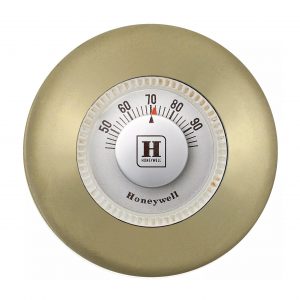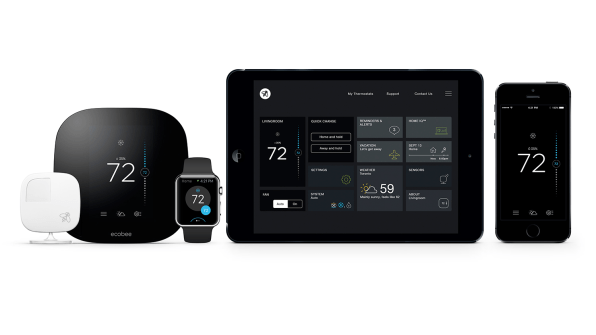All about thermostats. What is a thermostat? What are the differences in thermostats?

There was a time when it seemed nearly all thermostats were the basic round Honeywell-style thermostats. The mercury thermostat was considered cutting edge technology! Well we have come quite a long long way from there. Today there are many choices.
One note on those “Old Faithful” thermostats
Mercury can be dangerous. Old thermostats containing mercury are still in use However, in CT they have been outlawed for sale since 2003. We replace old mercury type thermostats for the energy economics gain over the danger factor. Mercury can be dangerous ONLY if the device is broken. Mercury is a highly toxic metal that can cause health problems. PLEASE NOTE, should you elect to replace your own thermostat, it is against federal regulations to throw it out in the trash. Your best option is to CONTACT US to switch out your thermostat and properly dispose of the old one.
Types of thermostats
Thermostats that control HVAC systems can be categorized by the type of power they require.
- 110V or 240V power: These are called high-voltage or line-voltage systems and include electric furnaces and electric baseboard heating systems.
- 24V power: These are called low-voltage systems and include most conventional split or package air conditioning and heating systems including heat pumps, as well as furnaces and boilers. Fuels include gas, oil, or even some electric systems.
- Millivolt power: These are OLD style gas-fired heaters that don’t use electricity for the control system however they MAY or may not have a blower (fan) or circulator pump.
Each type of HVAC system type requires a thermostat compatible with the power it uses. Note, most residential heating and air conditioning systems use 24V power, and these are the thermostats we will discuss in the rest of this article. However, there are still many different categories of 24V thermostats and options we’ll discuss in the following sections.
Programmable Thermostats Vs. Non-Programmable
Simply put, programmable thermostats allow some type of programming regarding a scheduled temperature adjustment. Non-programmable thermostats cannot be programmed. Many programmable thermostats can be set NOT to run a program, so the option can be left unused until needed.
Thermostats in this category are also called setback thermostats, allowing the user to set the temperature based on the day of the week and the time of the day. Most programmable thermostats allow for four settings per period, allowing a residential user, for instance, to have one setting early in the morning (Wake), a second one once everyone has left the house (Leave), a third for when people return home (Return), and a fourth one once everyone has gone to bed (Sleep).
There are two MAIN types of programmable thermostat.
- 5 +2 Day Thermostat: Supporting one schedule for Monday-Friday, and a second schedule for the weekend.
- 7 Day Thermostats: Supporting a different schedule for each day of the week.
These types of thermostats can generally be installed as direct replacements for common low voltage mercury or non-programmable digital thermostats with no wiring changes.
What are stages? Why do they exist?
Since HVAC equipment was first invented, they were manufactured with one operating mode. They were either on and running at full capacity or they were off. This is known as single-stage heating and cooling, 100% capacity being the only stage. Today, single-stage furnaces, heat pumps and ACs are still produced, but there are other options as well.
- Single-stage systems, as defined above, are made by every HVAC brand.
- Two-stage systems offer two stages of heating and cooling. The first stage is usually about 65% capacity, and second-stage is 100% capacity. The units run on the first stage most of the time. The advantages of lower capacity include better efficiency, quieter performance and temperatures that are more balanced. When the house cools off or warms rapidly due to changing outdoor temperatures, the system might need to run on 100% capacity for a cycle to compensate. If you change the thermostat setting by several degrees, second-stage/full-capacity heating or cooling might also be required. Every brand makes two-stage furnaces, ACs and heat pumps.
- Communicating or Variable capacity systems modulate at any percentage of capacity between about 40% and 100%. This ability takes the performance advantages of two-stage to the next level – the most efficient, quietest and most efficient and precise heating and cooling.
- Heat Pump systems require a special thermostat to control the stages of heating especially as many have an “emergency heat” feature.
Wi-Fi enabled thermostats are “smart thermostats.”
What’s all the buzz about concerning WiFi thermostats? There are a couple of advantages. Because they are Wi-Fi enabled, they may be controlled wirelessly, allowing the user to adjust the set points through a device such as a computer, smart phone, tablet, or watch while you’re away. You can also monitor your house while you’re away. Most of these apps can email or text you if the house gets too warm, too cold, too humid, or if the power goes out. Some of these advanced thermostats can monitor a freezer, sump pit, etc. and email you if there are any problems.

Many models go beyond that, being analytics capable, which means they offer the ability to drive additional energy savings through remotely-driven adjustments that can improve the efficiency of the heating/cooling system. Some thermostats also offer:
- E-mail communications through which the user can better understand their energy use,
- Occupancy-sensing/geofencing functionality (allowing the “away” setting to be activated when the building is unoccupied),
- Automatically adjusting the thermostat settings based on user behavior,
- Factoring in weather-related data to improve savings over time, and/or
- Allowing the thermostats to interact with other Wi-Fi enabled devices in the home.
There is one caveat to Wi-Fi thermostats. That is, that they need to be fed by power from the HVAC system and cannot be run on batteries like most digital thermostats. Not all systems have the appropriate number of wires (conductors) running to the existing thermostats. It is not always easy to get a new wire to some of these locations making Wi-Fi thermostats many times more expensive to install. This is not ALWAYS the case, however it is very often the case.
More tips regarding thermostats
Location is key. Many people don’t realize that the placement of the thermostat can have a direct effect on the energy use for a home or business. Finding a good location to place a thermostat can be difficult at times. Avoid direct sunlight, place it away from windows radiators, supply registers, and other sources of heat like electronics and lamps, and never in the kitchen.
The more the merrier. Having multiple zones with individual thermostats will help to save money heating or cooling the building in the long run. Some rooms or areas in your building may not be utilized as much as others. In larger open spaces or open floor plans, sensors can be used in conjunction with thermostats to average the temperatures for a more accurate number saving even more energy and money.
It is not always the thermostat. You may have noticed at times that you can’t get the temperature to your liking, don’t jump right to the idea that your thermostat is faulty. In reality, the problem usually stems from your HVAC system itself due to improper sizing, mechanical failure or poor duct-work sizing and construction. CONTACT US HERE to offer a more accurate diagnosis.
Thermostats are a vital part of our everyday comfort, so having a programmable thermostat installed in your home is a win-win situation. They are convenient, bring added comfort, and save you both energy and money.
Are you ready to upgrade your thermostat? Contact us today! We offer many lines of programmable thermostats and installation as well.
